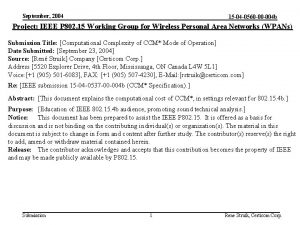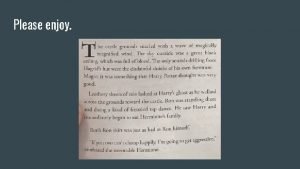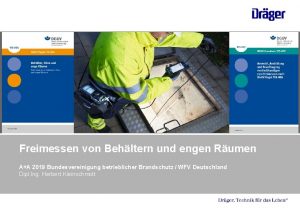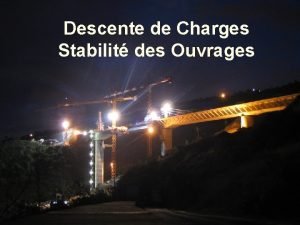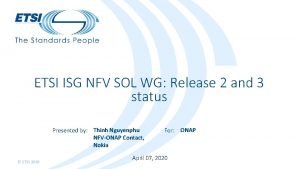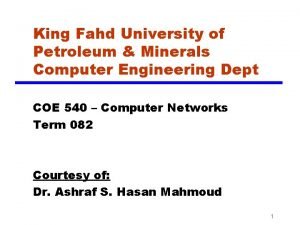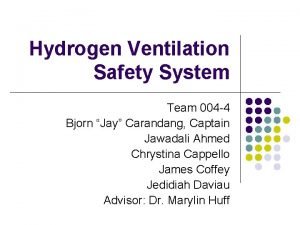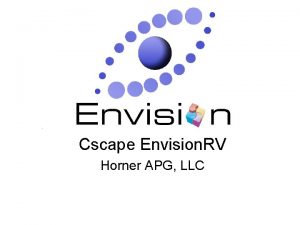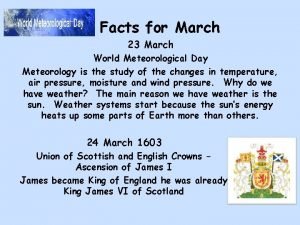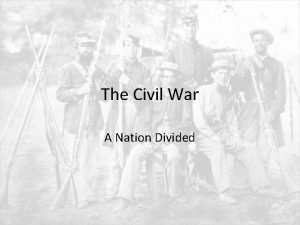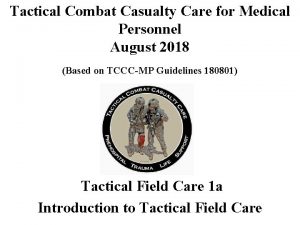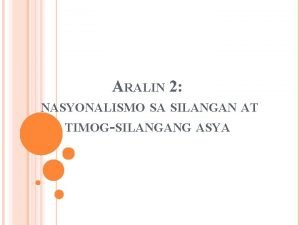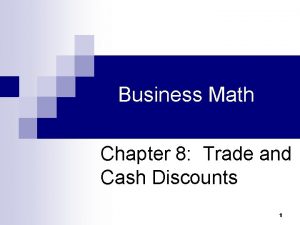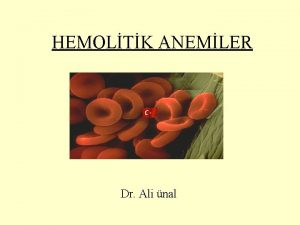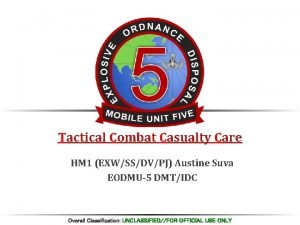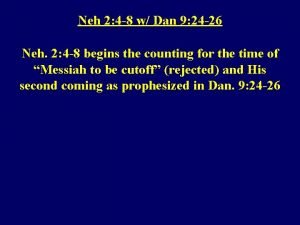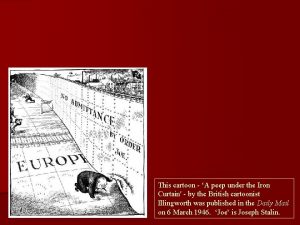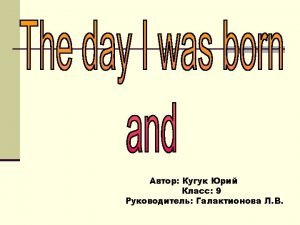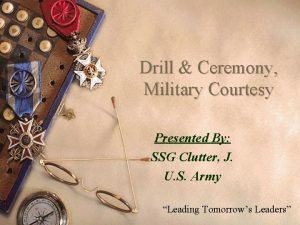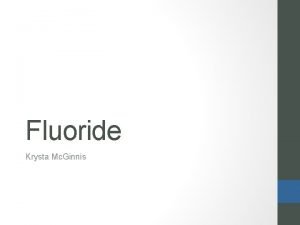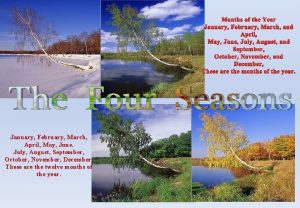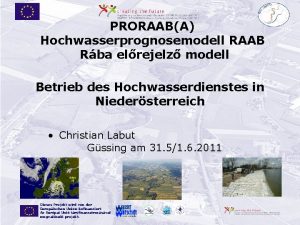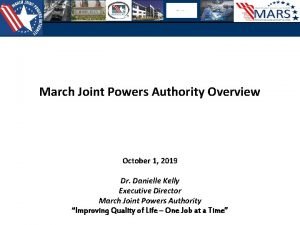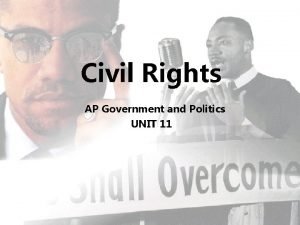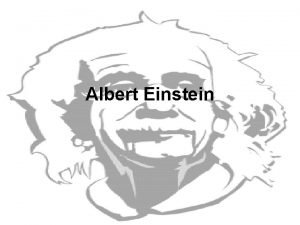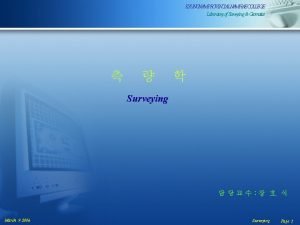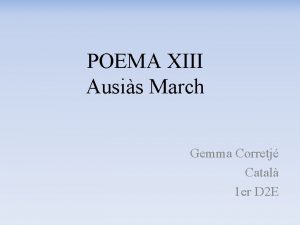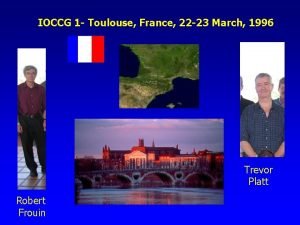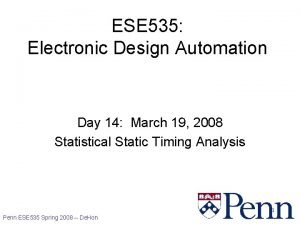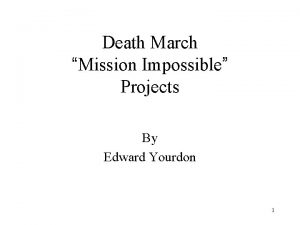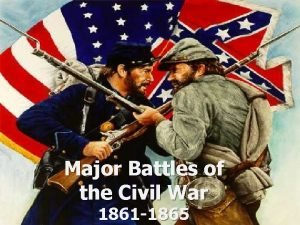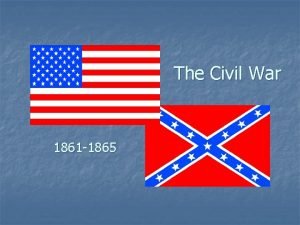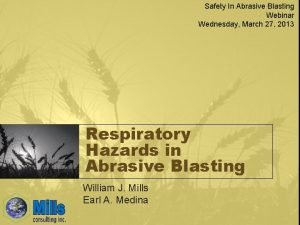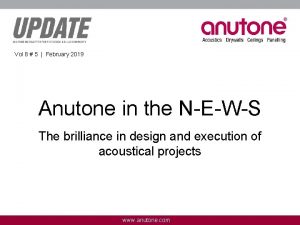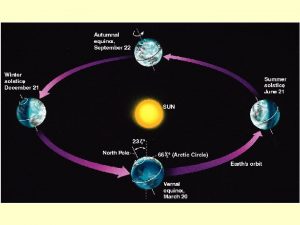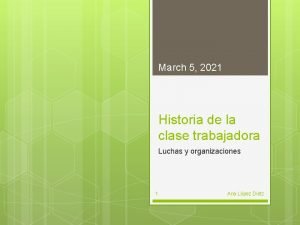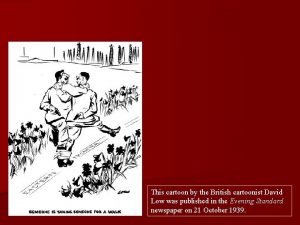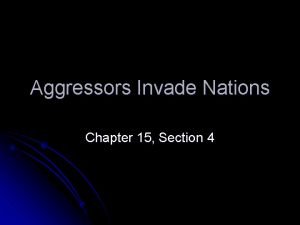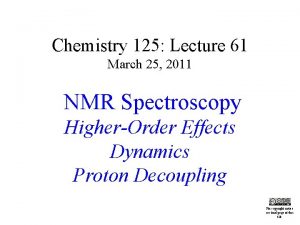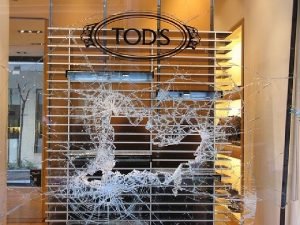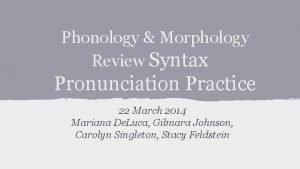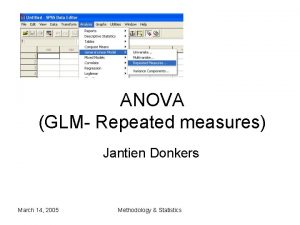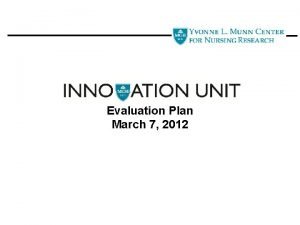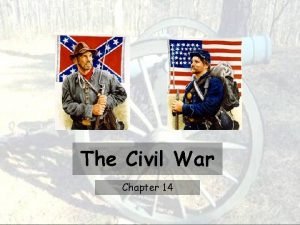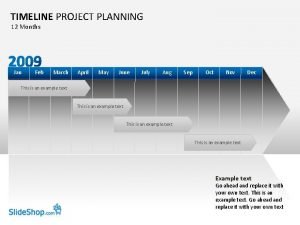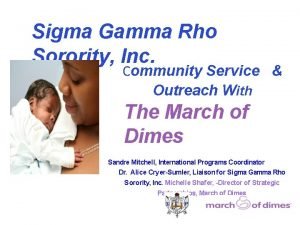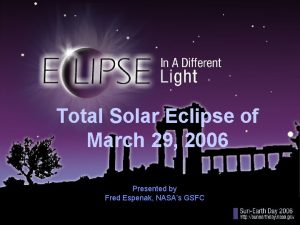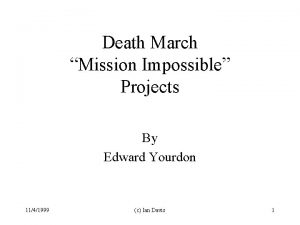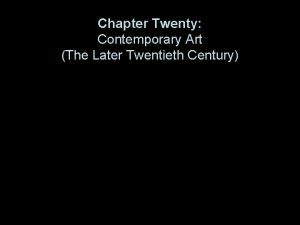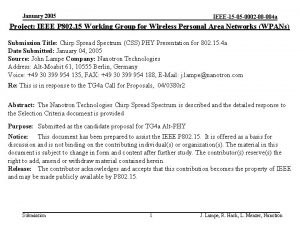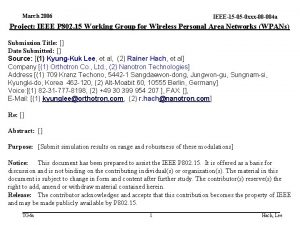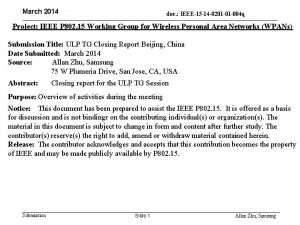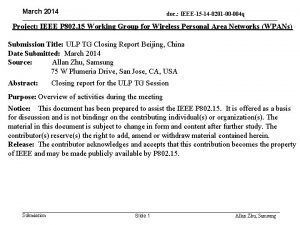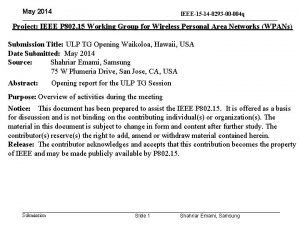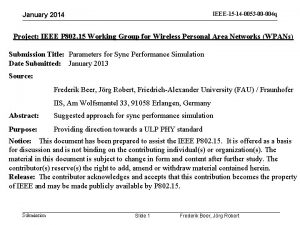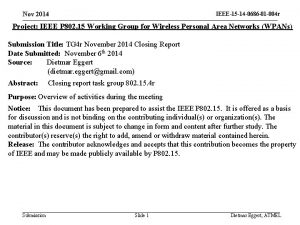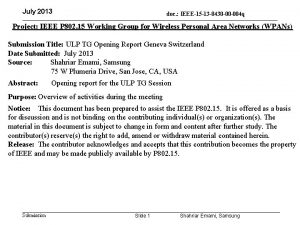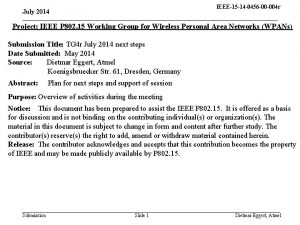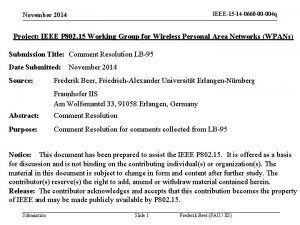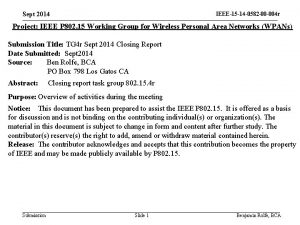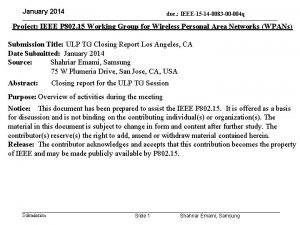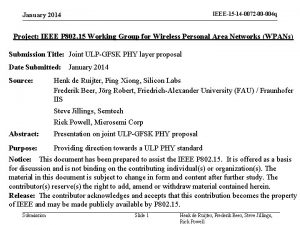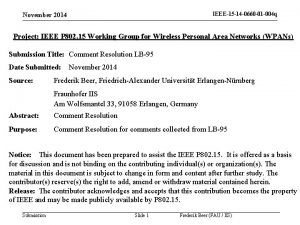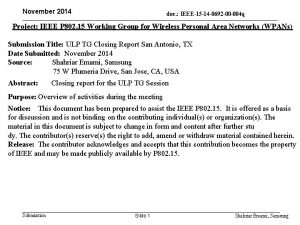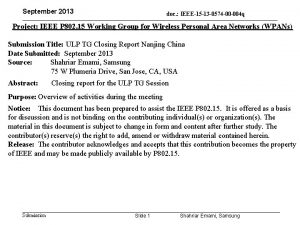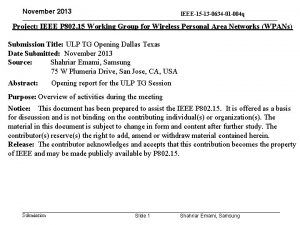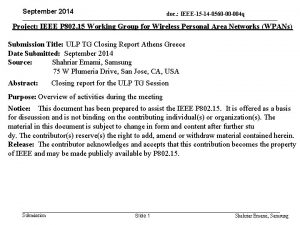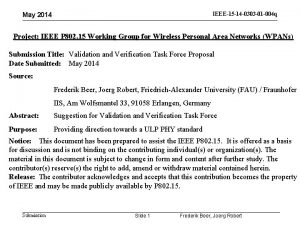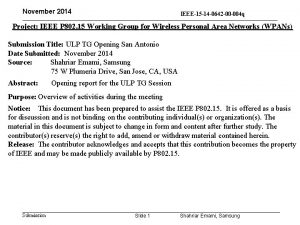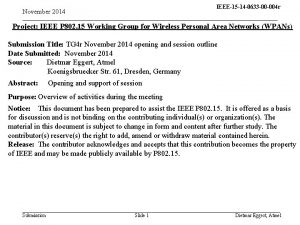March 2005 IEEE15 05 0126 01 004 a

















































































- Slides: 81

March 2005 IEEE-15 -05 -0126 -01 -004 a Project: IEEE P 802. 15 Working Group for Wireless Personal Area Networks (WPANs) Submission Title: DBO-CSS PHY Presentation for 802. 15. 4 a Date Submitted: March 07, 2005 Source: [(1) John Lampe, Rainer Hach, and Lars Menzer, (2) Kyung-Kuk Lee, Jong-Wha Chong, Sang. Hun Yoon, Jin-Doo Jeong, Sang-Dong Kim, Heun-Uk Lee] Company: [(1) Nanotron Technologies, (2) Orthotron Co. , Ltd. - Hanyang Univ] Address: [(1) Alt-Moabit 61, 10555 Berlin, Germany, (2) 709 Kranz Techono, 5442 -1 Sangdaewon-dong, Jungwon-gu, Sungnam-si, Kyungki-do, Korea 462 -120] Voice: [(1) +49 30 399 954 135, (2) 82 -31 -777 -8198 ], E-Mail: [(1) j. lampe@nanotron. com, (2) kyunglee@orthotron. com] Re: This is in response to the TG 4 a Call for Proposals, 04/0380 r 2 Abstract: The Nanotron - Orthotron DBO-CSS is described and the detailed response to the Selection Criteria document is provided Purpose: Submitted as the candidate proposal for TG 4 a Alt-PHY Notice: This document has been prepared to assist the IEEE P 802. 15. It is offered as a basis for discussion and is not binding on the contributing individual(s) or organization(s). The material in this document is subject to change in form and content after further study. The contributor(s) reserve(s) the right to add, amend or withdraw material contained herein. Release: The contributor acknowledges and accepts that this contribution becomes the property of IEEE and may be made publicly available by P 802. 15. Submission 1 Lampe, Hach, Menzer, Nanotron; Lee, Orthotron

March 2005 IEEE-15 -05 -0126 -01 -004 a Differentially Bi-Orthogonal Chirp-Spread-Spectrum PHY Proposal for 802. 15. 4 a by John Lampe, Rainer Hach, and Lars Menzer Nanotron Technologies Gmb. H, Germany j. lampe@nanotron. com Kyung-Kuk Lee / Jong-Wha Chong Orthotron Co. , Ltd. / Hanyang Univ. , Korea kyunglee@orthotron. com Submission 2 Lampe, Hach, Menzer, Nanotron; Lee, Orthotron

March 2005 IEEE-15 -05 -0126 -01 -004 a Contents ■ DBO-CSS System Overview ■ Selection Criteria Document Topics ■ PAR and 5 C Requirement Checklist ■ Summary Submission 3 Lampe, Hach, Menzer, Nanotron; Lee, Orthotron

March 2005 IEEE-15 -05 -0126 -01 -004 a DBO-CSS System Overview The merged proposal is different than and improves on the two original proposals! ■ Chirp Property ■ Concept of Sub-Chirps ■ Block-diagram ♣ DBO-CSS: Differentially Bi-Orthogonal Chirp-Spread-Spectrum Submission 4 Lampe, Hach, Menzer, Nanotron; Lee, Orthotron

March 2005 IEEE-15 -05 -0126 -01 -004 a DBO-CSS System Overview Chirp Properties Linear Chirp: Rectangular Window t t Linear Chirp: Raised-Cosine Window Correlation Property of Chirp Signal 1 0. 8 1 Amplitude 0. 8 0. 6 0. 4 0. 2 0. 6 0. 4 0 -0. 2 -0. 4 -0. 6 -0. 8 0 -1 -200 Submission 5 -150 -100 -50 0 50 100 150 200 Lampe, Hach, Menzer, Nanotron; Lee, Orthotron

March 2005 IEEE-15 -05 -0126 -01 -004 a DBO-CSS System Overview Concept of Sub-Chirps Spectrum Freq. – Time (Pass-band) fdiff. I fc 0 t -10 II Fbw = 7. 0 MHz rolloff = 0. 25; Fdiff = 6. 3 MHz; Tc = 4. 8 usec f. BW fc -20 t -30 III fc t IV -40 -50 fc t -20 -10 fc 10 20 (MHz) Same Spectrum with IEEE 802. 11 b Submission 6 Lampe, Hach, Menzer, Nanotron; Lee, Orthotron

March 2005 IEEE-15 -05 -0126 -01 -004 a DBO-CSS System Overview Concept of Sub-Chirps Freq. – Time (Passband) I II Baseband Waveform t t III t IV t Real Submission 7 Imaginary Envelope Lampe, Hach, Menzer, Nanotron; Lee, Orthotron

March 2005 IEEE-15 -05 -0126 -01 -004 a DBO-CSS System Overview Concept of Sub-Chirps Freq. – Time Property (Baseband) 1. 2μs 7 MHz 2. 4μs 3. 6μs 4. 8μs t 0. 96μs C(t) Baseband Waveform 1. 0 0. 5 t Real Submission 8 Imaginary Envelope Lampe, Hach, Menzer, Nanotron; Lee, Orthotron

March 2005 IEEE-15 -05 -0126 -01 -004 a DBO-CSS System Overview Block-diagram: DBO-CSS Transmitter Digital MOD Low-Pass Filter LP LP I/Q Modulator I f. T = f ± 10 MHz Q LO fc Submission 9 Lampe, Hach, Menzer, Nanotron; Lee, Orthotron

March 2005 IEEE-15 -05 -0126 -01 -004 a DBO-CSS System Overview I/Q Demodulator f. R = f. LO ± 10 MHz I LP ADC Diff Detector Bank Q LP ADC Correlator LO To. A estimator fc Submission Decode and Cotrol Block-diagram: DBO-CSS Receiver Digital Domain 10 Lampe, Hach, Menzer, Nanotron; Lee, Orthotron

March 2005 IEEE-15 -05 -0126 -01 -004 a DBO-CSS System Overview Bi-Orthogonal Mapping 8 -ary Bi-Orthogonal Symbol Mapping Table Decimal (m) 0 1 2 3 4 5 6 7 Binary (b 0, b 1, b 2) 000 001 010 011 100 101 110 111 Bi-Orthogonal Code (01, 02, 03, 04) 1 1 1 -1 -1 1 -1 -1 1 1 -1 3 bits/symbol Submission 11 Lampe, Hach, Menzer, Nanotron; Lee, Orthotron

March 2005 IEEE-15 -05 -0126 -01 -004 a DBO-CSS System Overview Block-diagram: 8 -ary Differentially Bi-Orthogonal Binary-Chirp-Spread-Spectrum (DBO-BCSS) Modulator Data-rate: 250 Kbps Q I Binary Data 1 S/P Symbol 3 Mapper 4 P/S 1 DBO-BCSS Gen. Submission 1 12 Lampe, Hach, Menzer, Nanotron; Lee, Orthotron

March 2005 IEEE-15 -05 -0126 -01 -004 a DBO-CSS System Overview Block-diagram: 8 -ary Differentially Bi-Orthogonal Quaternary-Chirp-Spread-Spectrum (DBO-QCSS) Modulator Data-rate: 1 Mbps Q 1 Binary Data 1 S/P Symbol 3 Mapper 4 P/S 1: 2 S/P Symbol S/P 3 Mapper 1 4 P/S QPSK 2 2 1 CSS Gen. Submission I 1 Mapper 13 DBO-QCSS Lampe, Hach, Menzer, Nanotron; Lee, Orthotron

March 2005 IEEE-15 -05 -0126 -01 -004 a DBO-CSS System Overview Block-diagram: 8 -ary DBO-QCSS Demodulator (Differential Detection) Baseband Signal A/D Differential Detector (Sub-Chirp) De. Orthogonal Time De. Spread Select Largest De. Map P/S FEC Decoding De. Scrambler Recovered Data Demodulator (Coherent Detection) Baseband Signal A/D Submission Rake Receiver (Sub-Chirp) De. Orthogonal Time De. Spread Select Largest De. Map 14 Diff. Decode P/S Recovered Data Lampe, Hach, Menzer, Nanotron; Lee, Orthotron

March 2005 IEEE-15 -05 -0126 -01 -004 a Selection Criteria Document Topic ■ Band in Use ■ Signal Robustness ■ Simultaneously Operating Piconets ■ Signal Acquisition ■ Clear Channel Assessment ■ System Performance interference mitigation techniques. Interference Susceptibility Coexistence ■ Technical Feasibility Error rate Receiver sensitivity Manufacturability Time to Market Regulatory Impact Backward Compatibility ■ ■ ■ ■ ■ Scalability Mobility MAC Protocol Supplement PHY Layer Criteria Ranging Link Budget Power Management Modes Power Consumption Antenna Practicality Unit Manufacturing Cost/Complexity (UMC) Size and Form Factor Payload Bit Rate and Data Throughput Submission 15 Lampe, Hach, Menzer, Nanotron; Lee, Orthotron

March 2005 IEEE-15 -05 -0126 -01 -004 a Selection Criteria Document Topic Band in Use: § 2. 4 GHz ISM Band: Same Operating Channels with 802. 11 b - Non-Overlap: fc = 2. 412 GHz, 2. 437 GHz, 2. 462 GHz (North America) / 2. 412 GHz, 2. 442 GHz, 2. 472 GHz (Europe) - Overlap: fc = 2. 412 GHz, 2. 422 GHz, 2. 432 GHz, 2. 442 GHz, 2. 452 GHz, 2. 462 GHz (North America, Europe) / 2. 472 GHz (Europe) § 20 MHz Bandwidth: 4 SOPs per Band Spectrum 0 -10 Fbw = 7. 0 MHz rolloff = 0. 25; Fdiff = 6. 3 MHz; Tc = 4. 8 usec -20 -30 -40 -50 -20 Submission fc -10 16 10 20 (MHz) Lampe, Hach, Menzer, Nanotron; Lee, Orthotron

March 2005 IEEE-15 -05 -0126 -01 -004 a Selection Criteria Document Topic Signal Robustness: ■ Co-existence / Interference Mitigation Technique - Orthogonal / Quasi-Orthogonal Signal Set High Spectral Processing Gain: Chirp Near-Far Problem: FDM Channels (3 non-overlapping ch @2. 4 GHz) Higher data rate CCA CSMA ■ Interference Susceptibility - Low Cross-Correlation property with Existing Signal - Adoption of 802. 11 Frequency Channels - Higher data rate shorter transmit time ■ Robustness: - Heavy Multi-path Environment: Differential Encoding - SOP: Good Orthogonality ■ Low Sensitivity for Component Tolerance - Crystal : ± 40 ppm ■ Mobility - Wide-band Chirp: Insensitive for Fading & Doppler Shift - Easily Maintaining Timing Sync. of Received Signal ■ CCA - Energy Detection, Symbol Detection Submission 17 Lampe, Hach, Menzer, Nanotron; Lee, Orthotron

March 2005 IEEE-15 -05 -0126 -01 -004 a Selection Criteria Document Topic Signal Robustness: Interference Susceptibility Support for Interference Ingress l Example (without FEC): – – – Submission Bandwidth B of the chirp = 20 MHz Duration time T of the chirp = 4. 8 µs Processing gain, BT product of the chirp > 17 d. B Eb/N 0 at detector input (BER=10 E-4) = 12. 5 d. B In-band carrier to interferer ratio: C/I @ BER=10 -4 > 12. 5 – 17 = -4. 5 d. B 18 Lampe, Hach, Menzer, Nanotron; Lee, Orthotron

March 2005 IEEE-15 -05 -0126 -01 -004 a Selection Criteria Document Topic Signal Robustness: Coexistence Low interference egress l IEEE 802. 11 b receiver – More than 30 d. B of protection in an adjacent channel – Almost 60 d. B in the alternate channel • These numbers are similar for the 802. 11 g receiver Submission 19 Lampe, Hach, Menzer, Nanotron; Lee, Orthotron

March 2005 IEEE-15 -05 -0126 -01 -004 a Selection Criteria Document Topic Signal Robustness: Coexistence WLAN Transmitters Dint. Receiver Under Test 100 Same Tx Power 10 -1 PER DBO-CSS Signal is not susceptible to W-LAN Interference System performance with IEEE 802. 11 b Interference 10 -2 10 -3 Desired Transmitter Dref. 10 -4 0. 45 0. 55 0. 65 0. 75 0. 85 0. 9 Dint. / Dref. Submission 20 Lampe, Hach, Menzer, Nanotron; Lee, Orthotron

March 2005 IEEE-15 -05 -0126 -01 -004 a Selection Criteria Document Topic Technical Feasibility: Manufacturability § No special components (precise crystal, SAW filter, …) required § Can be manufactured in single-chip CMOS : 0. 18 µm, or less § RF-CMOS 0. 18μm: Die Area: 4. 42 mm 2 § RF-CMOS 0. 13μm: Die Area: 3. 70 mm 2 Submission 21 Lampe, Hach, Menzer, Nanotron; Lee, Orthotron

March 2005 IEEE-15 -05 -0126 -01 -004 a Selection Criteria Document Topic Technical Feasibility: Time to Market l l No regulatory hurdles Chirp based chips are available on the market No big research barriers – well known technology Standard design and product cycles will apply Submission 22 Lampe, Hach, Menzer, Nanotron; Lee, Orthotron

March 2005 IEEE-15 -05 -0126 -01 -004 a Selection Criteria Document Topic Technical Feasibility: Regulatory Impact l Devices manufactured in compliance with the DBO-CSS proposal can be operated under existing regulations in all significant regions of the world - Including but not limited to North and South America, Europe, Japan, China, Korea, and most other areas - There are no known limitation to this proposal as to indoors or outdoors l The DBO-CSS proposal would adhere to the following worldwide regulations: - United States Part 15. 247 or 15. 249 - Canada DOC RSS-210 - Europe ETS 300 -328 - Japan ARIB STD T-66 Submission 23 Lampe, Hach, Menzer, Nanotron; Lee, Orthotron

March 2005 IEEE-15 -05 -0126 -01 -004 a Selection Criteria Document Topic Technical Feasibility: Backward Compatibility l Due to the usage of state of the art RF architecture it is possible to implement this proposal in a manner that will allow backward-compatibility with the 802. 15. 4 2. 4 GHz standard. l The transmitter changes are relatively straightforward. l Changes to the receiver would mainly consist of additions for To. A estimation and ranging l Optional methods for backward-compatibility could be left up to the implementer - Mode switching - Dynamic change (on-the-fly) technique l This backward-compatibility would be a significant advantage in the marketplace by allowing these devices to communicate with existing deployed 802. 15. 4 infrastructure and eliminating customer confusion. Submission 24 Lampe, Hach, Menzer, Nanotron; Lee, Orthotron

March 2005 IEEE-15 -05 -0126 -01 -004 a Selection Criteria Document Topic Scalability: Data-rate l Mandatory rate = 1 Mb/s l Optional rate = 250 Kb/s l Lower data rate is achieved by using interleaved FEC Submission 25 Lampe, Hach, Menzer, Nanotron; Lee, Orthotron

March 2005 IEEE-15 -05 -0126 -01 -004 a Selection Criteria Document Topic Scalability: Frequency Bands l The proposer is confident that the DBO-CSS proposal would also work well in other frequency bands in future revisions of the standard – For example: 5 GHz UNII / ISM bands Submission 26 Lampe, Hach, Menzer, Nanotron; Lee, Orthotron

March 2005 IEEE-15 -05 -0126 -01 -004 a Selection Criteria Document Topic Scalability: Power Levels l For extremely long ranges the transmit power may be raised to each country’s regulatory limit, for example: – The US would allow 30 d. Bm of output power with up to a 6 d. B gain antenna – The European ETSI limits would specify 20 d. Bm of output power with a 0 d. B gain antenna l Note that even though higher transmit power requires significantly higher current it doesn’t significantly degrade battery life since the transmitter has a much lower duty cycle than the receiver, typically 10% or less of the receive duty cycle. Submission 27 Lampe, Hach, Menzer, Nanotron; Lee, Orthotron

March 2005 IEEE-15 -05 -0126 -01 -004 a Selection Criteria Document Topic Mobility • Communication – No system inherent restrictions are seen for this proposal • The processing gain of chirp signals is extremely robust against frequency offsets such as those caused by the Doppler effect when there is a high relative speed vrel between two devices. • The Doppler effect must also be considered when one device is mounted on a rotating machine, wheel, etc. • The limits will be determined by other, general (implementation-dependent) processing modules (AGC, symbol synchronization, etc. ). • Ranging – The ranging scheme proposed in this document relies on the exchange of two hardware acknowledged data packets • One for each direction between two nodes – The total time for single-shot (2 data, 2 Ack) ranging procedure between the two nodes is the time tranging which, depending on the implementation, might be impacted by the u. C performance. During this time the change of distance should stay below the accuracy da required by the application. The worst case is: • For da = 1 m • tranging = 2 ms this yields • vrel << 1000 m/s Submission 28 Lampe, Hach, Menzer, Nanotron; Lee, Orthotron

March 2005 IEEE-15 -05 -0126 -01 -004 a Selection Criteria Document Topic MAC Protocol Supplement l There are very minimal anticipated changes to the 15. 4 MAC to support the proposed Alt-PHY. – 13 (11 for US) FD times 4 CD channels are called for with this proposal and it is recommended that the mechanism of channel bands from the proposed methods of TG 4 b be used to support the new channels. – There will be an addition to the PHY-SAP primitive to include the choice of data rate to be used for the next packet. This is a new field. l Ranging calls for new PHY-PIB primitives are expected to be developed by the Ranging subcommittee. Submission 29 Lampe, Hach, Menzer, Nanotron; Lee, Orthotron

March 2005 IEEE-15 -05 -0126 -01 -004 a Selection Criteria Document Topic PHY Layer Criteria: Manufacturing Cost/Complexity Base. Band Digital Tx Rx 1 Mbps / 250 Kbps [gates] 250 Kbps 1 Mbps Scrambler 154 O O FEC Encoder (r=1/2) 100 O X Symbol Mapper 13 O O Differential Encoder 56 O O Chirp-pulse Modulator 290 O O Framer & Others 1 K O O Differential Detector 39 k O O Symbol Demapper 200 O O Correlator 4. 2 O O Max Selector 100 O O FEC Decoder (r=1/2) (95 K) O X Descrambler 154 O O Deframer & Others 10 K O O 155. 2 K 60. 2 K Common 1. 5 K / 1. 6 K 53. 7 K / 148. 6 K 5 K Transceiver Submission Data-Rate Estimated Complexity 30 Lampe, Hach, Menzer, Nanotron; Lee, Orthotron

March 2005 IEEE-15 -05 -0126 -01 -004 a Selection Criteria Document Topic PHY Layer Criteria: Size and Form Factor l The implementation of the DBO-CSS proposal will be much less than SD Memory at the onset – Following the form factors of Bluetooth and IEEE 802. 15. 4 / Zig. Bee l The implementation of this device into a single chip is relatively straightforward – As evidenced in the “Unit Manufacturing Complexity” slides Submission 31 Lampe, Hach, Menzer, Nanotron; Lee, Orthotron

March 2005 IEEE-15 -05 -0126 -01 -004 a Selection Criteria Document Topic PHY Layer Criteria: Size and Form Factor SD Memory (32 mm X 24 mm) Pattern Antenna (24 mm X 14 mm) RF Base band Button Cell Battery 2. 4 GHz Ex) • Battery Capacity: 3 V x 30 m. Ah (324 Joule) • Dimension: 10 x 2. 5 (Dia. x Ht. mm) Submission 32 Lampe, Hach, Menzer, Nanotron; Lee, Orthotron

March 2005 IEEE-15 -05 -0126 -01 -004 a Selection Criteria Document Topic PHY Layer Criteria: Bit Rate and Data Throughput Payload Bit-rate: ■ Data-rate: 1 MHz / 250 Kbps per piconet ■ Aggregated Data-rate: Max. 4 Mbps (4 X 1 Mbps) per FDM Channel ■ FDM Channels: 13 (11) CH. (2. 4 GHz) Data Throughput: ■ Payload bit-rate 1 Mbps / 250 Kbps : Throughput 330 Kbps / 148 Kbps Payload: 32 byte 5 byte DATA Frame ACK Frame TACK 330 / 1104 μsec DATA Frame TLIFT 114 / 240 μsec 574 / 1474 μsec TACK = TLIFS = 192 usec Submission 33 Lampe, Hach, Menzer, Nanotron; Lee, Orthotron

March 2005 IEEE-15 -05 -0126 -01 -004 a Selection Criteria Document Topic PHY Layer Criteria: Bit Rate and Data Throughput Data Frame: Payload bit-rate : 1 Mbps (r=1) / 250 Kbps (r=1/2) 5 Chirps Preamble 1 Chirp Delimiter 6 Chirps 43 Chirps (1 Mbps) / 172 Chirps (250 Kbps) Length + Rate MPDU (8 + 1)bit (32 X 8 +2) bit 330 μsec (1 Mbps) / 1104 μsec (250 Kbps) ACK Frame: Payload bit-rate : 1 Mbps(r=1) / 250 Kbps (r=1/2) 5 Chirps Preamble 1 Chirp 6 Chirps 7 Chirps (1 Mbps) / 28 Chirps (250 Kbps) Delimiter Length + Rate MPDU (8 + 1)bit (5 X 8 +2) bit 114 μsec (1 Mbps) / 240 μsec (250 Kbps) Submission 34 Lampe, Hach, Menzer, Nanotron; Lee, Orthotron

March 2005 IEEE-15 -05 -0126 -01 -004 a Selection Criteria Document Topic PHY Layer Criteria: Bit Rate and Data Throughput 797 Kb/s 1 Mb/s plot 330 Kb/s 250 Kb/s plot 230 Kb/s 148 Kb/s Tack= 192 µs SIFS= 192 µs Submission 36 Lampe, Hach, Menzer, Nanotron; Lee, Orthotron

March 2005 IEEE-15 -05 -0126 -01 -004 a Selection Criteria Document Topic Simultaneously Operating Piconets l Separating Piconets by frequency division – This DBO-CSS proposal includes a mechanism for Frequency Devision (FD) by utilizing the frequency bands defined by 802. 11 b, g and also 802. 15. 3 • It is believed that the use of these bands will provide strong orthogonality which can easily combat the Near/Far problem – Furthermore this DBO-CSS proposal offers a mechanism for Code Devision (CD) utilizing the good correlation features of the Chirp signal. • It is believed that this will offer sufficient orthogonality for many situations – The proposed chirp signal has a rolloff factor of 0. 25 which in conjunction with the space between the adjacent frequency bands allows filtering out of band emissions easily and inexpensively. Submission 37 Lampe, Hach, Menzer, Nanotron; Lee, Orthotron

March 2005 IEEE-15 -05 -0126 -01 -004 a Selection Criteria Document Topic Simultaneously Operating Piconets Correlation Power (For Preamble Detection) I II IV CSS Signal : Quasi-Orthogonal Property Each of CSS Signal consists of 4 sub-chirp signals. Submission Correlation Property between the piconet Does not need Synchronization inter-piconet 38 Lampe, Hach, Menzer, Nanotron; Lee, Orthotron

March 2005 IEEE-15 -05 -0126 -01 -004 a Selection Criteria Document Topic Simultaneously Operating Piconets Complex Amplitude (for Data Demod) I II IV CSS Signal : Quasi-Orthogonal Property Correlation Property between piconet Each of CSS Signal consists of 4 sub-chirp signals. Submission 39 Lampe, Hach, Menzer, Nanotron; Lee, Orthotron

March 2005 IEEE-15 -05 -0126 -01 -004 a Selection Criteria Document Topic Simultaneously Operating Piconets Duration of 2 Symbols (12 usec) I 0. 3 usec d 11 2. 1 usec d 12 II 0. 6 usec d 21 1. 8 usec d 22 III 0. 9 usec d 31 1. 5 usec d 32 IV 4. 8 usec 1. 2 usec d 41 1. 2 usec d 42 l SOP: Assigning Different Time-Gap between the CSS Signal l Minimize ISI for CM 8 NLOS: Assign the Time-Gap between symbol more then 200 nsec Submission 40 Lampe, Hach, Menzer, Nanotron; Lee, Orthotron

March 2005 IEEE-15 -05 -0126 -01 -004 a Selection Criteria Document Topic Simultaneously Operating Piconets Interference Tested by Packet (32 bytes Random Data) I II IV Each of CSS Signal consists of 4 sub-chirp signals. Submission Differential Detection Property between piconet 41 Lampe, Hach, Menzer, Nanotron; Lee, Orthotron

March 2005 IEEE-15 -05 -0126 -01 -004 a Selection Criteria Document Topic Simultaneously Operating Piconets System Performance in 1 interf. piconet 0 10 AWGN CM 8 CM 1 CM 5 -1 -2 10 -3 10 10 -4 10 System performance with 2 interf. piconet 10 PER 0 10 -4 0 0. 5 1 1. 5 2 2. 5 10 3 0. 5 1 1. 5 Dint/Dref 0 10 AWGN CM 8 CM 1 CM 5 10 PER 2. 5 3 3. 5 System performance with 3 interf. piconet -1 Uncoordinated Piconets’ Transmitters Receiver Under Test Dint. -2 10 Desired Transmitter Dref. Available SOPs -3 10 l 2. 4 GHz: 4[piconets/FDM Ch. ] x 3[FDM Ch. ] = 12 SOPs l 2. 4 GHz: 4[piconets/FDM Ch. ] x 13[FDM Ch. ] = 52 SOPs -4 10 2 Dint/Dref 1 1. 5 2 2. 5 3 3. 5 4 Dint/Dref Submission 42 Lampe, Hach, Menzer, Nanotron; Lee, Orthotron

March 2005 IEEE-15 -05 -0126 -01 -004 a Selection Criteria Document Topic Signal Acquisition: Block-diagram A/D Differential Detector (T 1) Select Largest Symbol De-Mapper Data Differential Detector (T 2) Submission 43 Lampe, Hach, Menzer, Nanotron; Lee, Orthotron

March 2005 IEEE-15 -05 -0126 -01 -004 a Selection Criteria Document Topic Signal Acquisition: Miss Detection Probability, Pm n=2 Preamble Detection Submission 44 Lampe, Hach, Menzer, Nanotron; Lee, Orthotron

March 2005 IEEE-15 -05 -0126 -01 -004 a Selection Criteria Document Topic Signal Acquisition l This DBO-CSS proposal is based upon a preamble of 5 Chirp symbols which results in a duration of 30 µs. This value is significantly below the duration of preamble defined in 15. 4 and thus increases the available throughput. l Existing implementations demonstrate that modules, which might be required to be adjusted for reception (gain control, frequency control, peak value estimation, etc. ), can settle in this time. Submission 45 Lampe, Hach, Menzer, Nanotron; Lee, Orthotron

March 2005 IEEE-15 -05 -0126 -01 -004 a Selection Criteria Document Topic Clear Channel Assessment ■ A combination of symbol detection (SD) and energy detection (ED) has proven to be useful in practice (e. g. 802. 11 x, 802. 15. 4). ■ CCA is used by the 15. 4 MAC to significantly increase the number of active nodes possible by reducing the probability of collisions. Submission 46 Lampe, Hach, Menzer, Nanotron; Lee, Orthotron

March 2005 IEEE-15 -05 -0126 -01 -004 a Selection Criteria Document Topic System Performance ■ This proposal refers to the 2. 4 GHz ISM band. Although some channel models start at 3 GHz and thus don’t include the 2. 4 GHz band, simulations will be run over all channel models in order to prove the strength of this proposal. ■ As minimum the transmissions of 100 packets with 32 bytes over each channel realization are simulated Submission 47 Lampe, Hach, Menzer, Nanotron; Lee, Orthotron

March 2005 IEEE-15 -05 -0126 -01 -004 a Selection Criteria Document Topic System Performance ■ For some channel models the path loss exponent given is relatively small (e. g, for CM 1: n=1. 79) ■ In order to stimulate transmission errors, simulations have to be performed for ranges much beyond what the channel models have been specified for. Submission 48 Lampe, Hach, Menzer, Nanotron; Lee, Orthotron

March 2005 IEEE-15 -05 -0126 -01 -004 a Selection Criteria Document Topic System Performance Data Rate : 1 Mbps (QPSK) System Performance 0 10 AWGN CM 8 CM 1 CM 5 -1 PER 10 -2 10 -3 10 -4 10 Submission 10 12 14 16 Eb/No 49 18 20 22 Lampe, Hach, Menzer, Nanotron; Lee, Orthotron

March 2005 IEEE-15 -05 -0126 -01 -004 a Selection Criteria Document Topic System Performance n=2 AWGN Data Rate : 1 Mbps (QPSK) Distance (meter) Submission 50 Lampe, Hach, Menzer, Nanotron; Lee, Orthotron

March 2005 IEEE-15 -05 -0126 -01 -004 a Selection Criteria Document Topic System Performance Residential: CM 1: LOS (n=1. 79) Submission 7 m~20 m CM 2: NLOS (n=4. 58): 51 Lampe, Hach, Menzer, Nanotron; Lee, Orthotron

March 2005 IEEE-15 -05 -0126 -01 -004 a Selection Criteria Document Topic System Performance Office: 3 m~28 m CM 3: LOS (n=1. 63) Submission CM 4: NLOS (n=3. 07): 52 Lampe, Hach, Menzer, Nanotron; Lee, Orthotron

March 2005 IEEE-15 -05 -0126 -01 -004 a Selection Criteria Document Topic System Performance Industrial: 2 m~8 m CM 8: NLOS (n=2. 15): Submission 53 Lampe, Hach, Menzer, Nanotron; Lee, Orthotron

March 2005 IEEE-15 -05 -0126 -01 -004 a Selection Criteria Document Topic Ranging TOA Estimation § § § Coarse: Differential demodulation peak Fine: Correlation peak Precise: Receive signal post-processing e. g. : Spectrum estimation, curve fitting, … TOA Processing § § § Submission SDS TWR Technique Error Sensitivity Analysis Simulation Results 54 Lampe, Hach, Menzer, Nanotron; Lee, Orthotron

March 2005 IEEE-15 -05 -0126 -01 -004 a Selection Criteria Document Topic Ranging: TOA Estimation for Ranging Noise and Jitter of Band-Limited Pulse Given a band-limited pulse with noise σu we want to estimate how the jitter (timing error) σt, is affected by the bandwidth B. Jitter can be represented as a variation in the rising edge of a pulse through a given threshold, Approximate the impact of σu by: Assume the rising speed of the signal is proportional to the signal bandwidth: Since the power σ2 of band-filtered AWGN is proportional to the bandwidth we know that: Which leads to: Submission 55 Lampe, Hach, Menzer, Nanotron; Lee, Orthotron

March 2005 IEEE-15 -05 -0126 -01 -004 a Selection Criteria Document Topic Ranging: TOA Estimation for Ranging ■ The SN at the matched filter output is 2 Es/N 0 ■ If we assume a pulse with a rise time trise which is the inverse of the pulse bandwidth B (trise = 1/B) we can derive: ■ Bandwidth and signal to noise ratio can be traded against each other. ■ This proposal provides a signal to noise ratio which is high enough to compensate it’s limited bandwidth! Submission 56 Lampe, Hach, Menzer, Nanotron; Lee, Orthotron

March 2005 IEEE-15 -05 -0126 -01 -004 a Selection Criteria Document Topic Ranging: TOA Estimation Using Chirp Signals ■ Coarse Timing Detection - Peak of Differential Detection ■ Fine Timing Detection - Cross-Correlation of Sampled Input Signal - Fine Timing by Interpolation (Fraction of Sampling-Clock Resolution < 1 nsec) - Ranging Resolution better than 1 m @ Eb/No >= 24 d. B Arbitrary Sampling Instant Detected Timing Peak Edge Submission 57 Lampe, Hach, Menzer, Nanotron; Lee, Orthotron

March 2005 IEEE-15 -05 -0126 -01 -004 a Selection Criteria Document Topic Ranging: TOA Estimation Using Chirp Signals ■ Estimation Error: < 1 m @ Eb/No greater than 24 d. B Timing-error Variance (Chirp BW: 20 MHz) AWGN Submission 58 Lampe, Hach, Menzer, Nanotron; Lee, Orthotron

March 2005 IEEE-15 -05 -0126 -01 -004 a Selection Criteria Document Topic Ranging: TOA Estimation Using Chirp Signals Precise Timing Detection: Spectrum estimation One special property of chirp signals is that Time shifts can be transformed into frequency shifts TOA estimation can be transformed to spectrum estimation. Advantages: 1) Wide bandwidth and high sampling frequency are not required 2) Spectrum estimation is a well studied problem Submission 59 Lampe, Hach, Menzer, Nanotron; Lee, Orthotron

March 2005 IEEE-15 -05 -0126 -01 -004 a Selection Criteria Document Topic Ranging: TOA Estimation Using Chirp Signals Precise Timing Detection: Spectrum estimation A Assume a linear chirp signal t and a time-shifted copy of this signal f t A t By multiplying the two, a constant frequency signal is generated! f t Submission 60 Lampe, Hach, Menzer, Nanotron; Lee, Orthotron

March 2005 IEEE-15 -05 -0126 -01 -004 a Selection Criteria Document Topic Ranging: TOA Estimation Using Chirp Signals Precise Timing Detection: Spectrum estimation h Given a channel impulse response (CIR), t A t f transmitting a chirp signal over it, t and multiplying with a chirp signal of equal characteristic… A t will result in a signal with frequency components corresponding to the pulses of the CIR. f power t frequency Submission 61 Lampe, Hach, Menzer, Nanotron; Lee, Orthotron

March 2005 IEEE-15 -05 -0126 -01 -004 a Selection Criteria Document Topic Ranging: TOA Estimation Using Chirp Signals Precise Timing Detection: Spectrum estimation l From the estimated frequency components, the time positions of the multipath components can be calculated thus l The time of the first arrival can be found! Submission 62 Lampe, Hach, Menzer, Nanotron; Lee, Orthotron

March 2005 IEEE-15 -05 -0126 -01 -004 a Selection Criteria Document Topic Ranging: TOA Estimation Using Chirp Signals • Precise Timing Detection: curve fitting, … Curve fitting and other approaches for TOA estimation exist. They are currently under investigation. Thus a number of choices will be available! Submission 63 Lampe, Hach, Menzer, Nanotron; Lee, Orthotron

March 2005 IEEE-15 -05 -0126 -01 -004 a Selection Criteria Document Topic §Ranging: TOA Processing A method is required in order to minimize errors caused by crystal oscillator: § Resolution § Accuracy § Drift § Aging Submission 64 Lampe, Hach, Menzer, Nanotron; Lee, Orthotron

March 2005 IEEE-15 -05 -0126 -01 -004 a Ranging: TOA Processing Symmetrical Double-Sided Two-Way Ranging (SDS TWR) • Accuracy of range estimation is restricted by various factors: E = ECLOCK + ETOA_res + ETOA_noise + ETOA_offset + … Error Caused by Multiple Transmission Paths Total Error of Range Estimate Error caused by time base accuracy Submission Error Caused by Noise, Jitter, Interference, … Error of TOA estimation caused by restricted clock resolution 65 Lampe, Hach, Menzer, Nanotron; Lee, Orthotron

March 2005 IEEE-15 -05 -0126 -01 -004 a Ranging: TOA Processing: SDS TWR • SDS TWR elegantly cancels time base offset errors E = ECLOCK + ETOA_res + ETOA_noise + ETOA_offset + … Error caused by time base accuracy Submission 66 Lampe, Hach, Menzer, Nanotron; Lee, Orthotron

March 2005 IEEE-15 -05 -0126 -01 -004 a Ranging: TOA Processing: SDS TWR • How to measure a message sequence of milliseconds-length and achieve picoseconds-accuracy ? • Error of commercial quartz crystals is ± 40 ns over 1 ms (40 ppm, over a temperature range -40. . 85°C): Source: Jauch Quartz Gmb. H • Remind: 40 ns is equal to a distance of 12 m (40 feet) ! Submission 67 Lampe, Hach, Menzer, Nanotron; Lee, Orthotron

March 2005 IEEE-15 -05 -0126 -01 -004 a Ranging: TOA Processing: SDS TWR Tround. A Treply. A Node A Tprop t Node B Treply. B Tround. . . round trip time Treply. . . reply time Tprop. . . propagation of pulse Tround. B t Double-Sided: Each node executes a round trip measurement. Symmetrical: Reply Times of both nodes are identical (Treply. A =Treply. B). Results of both round trip measurements are used to calculate the distance. Submission 68 Lampe, Hach, Menzer, Nanotron; Lee, Orthotron

March 2005 IEEE-15 -05 -0126 -01 -004 a Ranging: TOA Processing Accuracy of SDS TWR • Calculation of Distance d: • Calculation of Distance Error EAB: • Result: Distance accuracy is equivalent to the average of time base accuracies (some tens ppm of distance only) ! Distance accuracy is independent of round trip & reply time ! c = speed of light, Et. A. . . error of time base at node A, Et. B. . . error of time base at node B Submission 70 Lampe, Hach, Menzer, Nanotron; Lee, Orthotron

March 2005 Ranging: TOA Processing Symmetry Error of SDS TWR IEEE-15 -05 -0126 -01 -004 a • Symmetry Error is Present in Practical Implementations: • Calculation of Distance Error EAB : • Result: Distance accuracy is independent of round trip & reply time ! Distance accuracy increases with decreasing of the Symmetry Error ∆Treply ! c = speed of light, Et. A. . . error of time base at node A, Et. B. . . error of time base at node B Submission 71 Lampe, Hach, Menzer, Nanotron; Lee, Orthotron

March 2005 IEEE-15 -05 -0126 -01 -004 a Selection Criteria Document Topic Ranging: Influence of Symmetry Error Example system Et. A = ± 40 ppm, Et. B = ± 40 ppm (worst case combination): ∆d (ΔTreply = 20 ns) d § ∆d (ΔTreply = 200 ns) ∆d (ΔTreply = 2 µs) ∆d (ΔTreply = 20 µs) 10 cm ± 0. 012 cm ± 0. 12 cm ± 12 cm 10 m ± 0. 05 cm ± 0. 12 cm ± 12 cm 100 m ± 0. 4 cm ± 1. 2 cm ± 12 cm 1 km ± 4 cm ± 12 cm 10 km ± 40 cm A ΔTreply of between 2 µs and 20 µs is typical for a low-cost implementation. – Implementations with symmetry error below 2 µs are feasible. § Conclusion: Even a 20 µs symmetry error allows excellent single-pulse accuracy of distance. Submission 72 Lampe, Hach, Menzer, Nanotron; Lee, Orthotron

March 2005 IEEE-15 -05 -0126 -01 -004 a Selection Criteria Document Topic Ranging: Simulation of a SDS TWR System Example system: Simulates SDS TWR + Dithering & Averaging Crystal Errors ± 40 ppm Single shot measurements @ 1 MBit/s data rate (DATA-ACK) Transmit Jitter = ± 4 ns (systematic/pseudo RN-Sequence) Pulse detection resolution = 4 ns Pulses averaged per packet = 32 Symmetry error = 4 µs (average) Distance = 100 m Results of Distance Error ∆d: |∆d. WC| < 50 cm |∆d. RMS| < 20 cm Submission 73 Lampe, Hach, Menzer, Nanotron; Lee, Orthotron

March 2005 IEEE-15 -05 -0126 -01 -004 a Selection Criteria Document Topic Link Budget Parameter Peak payload bit rate(Rb) mandatory option 1 option 2 1000 250 kbps Average Tx Power(Pt) 10 10 1000 m. W Average Tx Power(Pt) 10 10 30 d. Bm 0 0 0 d. Bi fc' = sqrt(fminfmax) -10 d. B 2. 44 GHz Path loss at 1 meter(L 1=20 log 10(4 pifc'/c)) 40. 2 d. B 30 1000 m 29. 5 40 60 d. B 0 0 0 d. Bi -59. 7 -70. 2 d. Bm -114. 0 -120. 0 d. Bm 7 7 7 d. B -107. 0 -113. 0 d. Bm 12. 5 d. B 3 3 3 d. B Link Margin (M=Pr-Pn-S-I) @ distance d 31. 8 27. 3 d. B Proposed Min. Rx Sensitivity Level -91. 5 -97. 5 d. Bm Tx antenna gain(Gt) Distance Path loss at d m(L 2=20 log 10(d)) Rx antenna gain(Gr) Rx power(Pr = Pt+Gt+Gr-L 1 -L 2(d. B)) Average noise power per bit Rx Noise Figure(Nf) Average noise power per bit(Pn=N+Nf) Minimum Eb/No(S) Implementation Loss(I) Submission 74 Lampe, Hach, Menzer, Nanotron; Lee, Orthotron

March 2005 IEEE-15 -05 -0126 -01 -004 a Selection Criteria Document Topic Power Management Modes l Power management aspects of this proposal are consistent with the modes identified in the IEEE 802. 15. 4: 2003 standard l There are no modes lacking nor added l Once again, attention is called to the 1 Mbit/s basic rate of this proposal and resulting shorter “on” times for operation Submission 76 Lampe, Hach, Menzer, Nanotron; Lee, Orthotron

March 2005 IEEE-15 -05 -0126 -01 -004 a Selection Criteria Document Topic Power Consumption The typical DSSS receivers, used by 802. 15. 4, have a complexity which is similar to the envisioned DBO-CSS receiver l Major differences are the differential encoder and decoder – The power consumption for a 10 d. Bm transmitter should be 198 m. W or less l The receiver for the DBO-CSS can if restricted to differential detection be implemented with to slightly complexity than that of the DSSS with the major difference that for communication no chip rate correlator is required. – The difference in power consumptions between these correlators is negligible so the power consumption for a 6 d. B NF receiver should be 40 m. W or less l Power save mode is used most of the time for this device and has the lowest power consumption – Typical power consumptions for 802. 15. 4 devices are 3 µW or less l Energy per bit is the power consumption divided by the bit rate – The energy per bit for the 10 d. Bm transmitter is less than 0. 2 µJ – The energy per bit for the receiver is 60 n. J l As an example, the energy consumed during an exchange of a 32 octet PDU between two devices would be 70. 6 µJ for the sender and 33. 2 µJ for the receiver. Submission 77 Lampe, Hach, Menzer, Nanotron; Lee, Orthotron

March 2005 IEEE-15 -05 -0126 -01 -004 a Selection Criteria Document Topic Power Consumption 1 Mbps RF @ Tx Power: 10 m. W Logic Die Area Power Tx + D/A - 1. 7 mm 2 187 m. W Rx + A/D - 1. 6 mm 2 28. 9 m. W Common - 0. 3 mm 2 10 m. W Tx 1. 5 K 0. 04 mm 2 0. 48 m. W 1. 6 K 0. 06 mm 2 0. 52 m. W Rx 53. 7 K 0. 69 mm 2 0. 77 m. W 148. 6 K 1. 54 mm 2 2. 18 m. W Common 5 K 0. 08 mm 2 0. 42 m. W 60. 2 K 4. 41 mm 2 155. 2 K 5. 28 mm 2 Baseband @ Sampling-rate: 40 MHz 250 Kbps (FEC: r=1/2) Total Tx Rx Deep Sleep 197. 9 m. W 40. 1 m. W 3 μW 198 m. W 41. 5 m. W 3 μW Target Library : 0. 18 um Technology ■ Power Consumption for Average Throughput 1 Kbps (w/o FEC) - PTX : 197. 9[m. W] / 330 = 600 [μW] - PRX : 40. 1[m. W] /330 = 121. 5 [μW] ■ Battery: 324[Joule] for Button Cell (10 mm D. X 2. 5 mm H) / 12, 000[Joules] for AA Alkaline Cell - (PTX + 50 X PRX)/51 = 130. 9[u. W] ----- (Assume TTX : TRX = 1: 50 duty-cycle for sensor node) - Battery Life TB = 324/130. 9 e-6/3600/24 = 28. 6 days Continuously (Button Cell) - Battery Life TB = 12000/130. 9 e-6/3600/24/365 = 2. 91 years Continuously (AA Alkaline Cell) Submission 78 Lampe, Hach, Menzer, Nanotron; Lee, Orthotron

March 2005 IEEE-15 -05 -0126 -01 -004 a Selection Criteria Document Topic Antenna Practicality l The antenna for this DBO-CSS proposal is a standard 2. 4 GHz antenna such as widely used for 802. 11 b, g devices and Bluetooth devices. l These antennas are very well characterized, widely available, and extremely low cost. l Additionally there a multitude of antennas appropriate for widely different applications. l The size for these antennae is consistent with the SCD requirement. Submission 79 Lampe, Hach, Menzer, Nanotron; Lee, Orthotron

March 2005 IEEE-15 -05 -0126 -01 -004 a Selection Criteria Document Topic Antenna Practicality ■ Antenna Size - Smaller than SD-Memory: 24 mm X 14 mm @2. 4 GHz ■ Frequency / Impulse Response - Almost flat frequency response: narrow-band ■ Radiation Characteristics - Isotropic: 0 d. Bi Submission 80 Lampe, Hach, Menzer, Nanotron; Lee, Orthotron

March 2005 IEEE-15 -05 -0126 -01 -004 a PAR and 5 C Requirement Checklist Submission 81 Lampe, Hach, Menzer, Nanotron; Lee, Orthotron

March 2005 IEEE-15 -05 -0126 -01 -004 a Requirements Checklist DBO-CSS Proposal Meets the PAR and 5 C: ü Precision ranging capability accurate to one meter or better ü Extended range over 802. 15. 4 -2003 ü Enhanced robustness over 802. 15. 4 -2003 ü Enhanced mobility over 802. 15. 4 -2003 ü International standard ü Ultra low complexity (comparable to the goals for 802. 15. 4 -2003) ü Ultra low cost (comparable to the goals for 802. 15. 4 -2003) ü Ultra low power consumption (comparable to the goals for 802. 15. 4 -2003) ü Support coexisting networks of sensors, controllers, logistic and peripheral devices in multiple compliant co-located systems. Submission 82 Lampe, Hach, Menzer, Nanotron; Lee, Orthotron

March 2005 IEEE-15 -05 -0126 -01 -004 a Summary The merged proposal is different than and improves on the two original proposals! Submission 83 Lampe, Hach, Menzer, Nanotron; Lee, Orthotron

March 2005 IEEE-15 -05 -0126 -01 -004 a Summary DBO-CSS is simple, elegant, efficient: l l l l Combines DSSS and UWB strengths Precise location-awareness Robustness – multipath, interferers, correlation, FEC, channelized, CCA Mobility enhanced Optional backward compatibility with 802. 15. 4 -2003 Excellent throughput SOPs – FD channels and CD channels Signal Acquisition – excellent Link Budget and Sensitivity – excellent Very minimal MAC changes, CCA supported Power Management and Consumption - meets or exceeds requirements Antenna – many good choices Can be implemented with today’s technologies • • • Low-complexity, low-cost Size and Form Factor – meets or exceeds requirements Low power consumption l Globally certifiable l Scalability with many options for the future l Meets all PAR and 5 C requirements Submission 84 Lampe, Hach, Menzer, Nanotron; Lee, Orthotron
 Anthem of poland
Anthem of poland 0560 004
0560 004 700 004
700 004 Dguv r 113-004
Dguv r 113-004 Chapeau ferraillage
Chapeau ferraillage Sol 005
Sol 005 Pyp 004 kfupm
Pyp 004 kfupm Team-004
Team-004 Auec2-001
Auec2-001 What are the vegetables outside the pentagon
What are the vegetables outside the pentagon Cscape envisionrv
Cscape envisionrv March 23 world meteorological day
March 23 world meteorological day Sherman's march significance
Sherman's march significance Just bingo
Just bingo March algorithm
March algorithm March 22 2010
March 22 2010 Demokrasya: dr. sun yat-sen; komunismo
Demokrasya: dr. sun yat-sen; komunismo How to find discount percent
How to find discount percent Transpiration practical grade 10
Transpiration practical grade 10 Metiltopa
Metiltopa March algorthym
March algorthym Bccbb
Bccbb Cartoon by leslie gilbert illingworth, 6 march 1946
Cartoon by leslie gilbert illingworth, 6 march 1946 January february march april may june
January february march april may june Genetic engineering conclusion
Genetic engineering conclusion Philip
Philip The annunciation march 25
The annunciation march 25 24 march zodiac
24 march zodiac French revolution women's march
French revolution women's march Counter column march
Counter column march 1965 march
1965 march January february maruary
January february maruary March 2 success.com
March 2 success.com Celebrated on march 17
Celebrated on march 17 Wasserstand bernhardsthal
Wasserstand bernhardsthal Opie childhood sociology
Opie childhood sociology March joint powers authority
March joint powers authority Glasgow 5 march 1971
Glasgow 5 march 1971 When is spring summer autumn and winter
When is spring summer autumn and winter Letter to senator robert wagner 1934
Letter to senator robert wagner 1934 1965 march
1965 march March 14 1879
March 14 1879 Geogrphic
Geogrphic 20 mile march
20 mile march Che guevara aleida march de la torre
Che guevara aleida march de la torre Macro march
Macro march Ausias march poema xiii
Ausias march poema xiii 23 march 1996
23 march 1996 March 1917 revolution
March 1917 revolution Welcome to our english class
Welcome to our english class Happy wednesday march
Happy wednesday march Critical essay structure
Critical essay structure March madness banner
March madness banner March identifier clips
March identifier clips 535 before 14 march
535 before 14 march Death march edward yourdon
Death march edward yourdon Slice march
Slice march Sherman's march to the sea
Sherman's march to the sea Path of sherman's march to the sea
Path of sherman's march to the sea Poem for 8 march
Poem for 8 march Weekly quiz answers 2021
Weekly quiz answers 2021 Source
Source Grihalakshmi magazine march 2019
Grihalakshmi magazine march 2019 21 march equinox
21 march equinox March 5 2021
March 5 2021 Evening standard cartoon
Evening standard cartoon Chapter 15 section 4 - aggressors invade nations answer key
Chapter 15 section 4 - aggressors invade nations answer key March 25 2011
March 25 2011 Salt march
Salt march Glasgow 5th march
Glasgow 5th march March verb
March verb What is ngo
What is ngo March april may season
March april may season Glm repeated measures spss
Glm repeated measures spss March 7, 2012
March 7, 2012 Why is the long march important
Why is the long march important Sherman's march to the sea map
Sherman's march to the sea map Jan feb mar
Jan feb mar Sigma gamma rho march of dimes
Sigma gamma rho march of dimes Astronomy picture of the day march 29 2006
Astronomy picture of the day march 29 2006 Death march edward yourdon
Death march edward yourdon Heath of the brandenburg march
Heath of the brandenburg march

